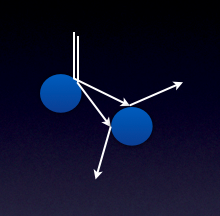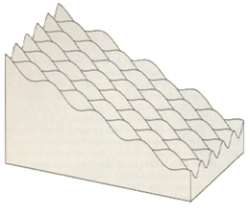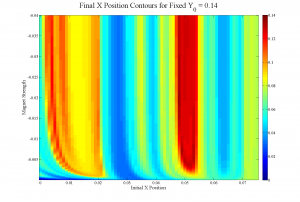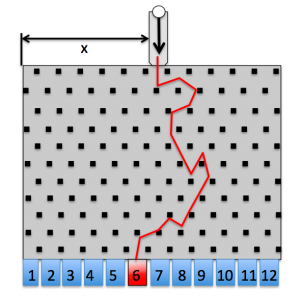Group 2: Difference between revisions
No edit summary |
No edit summary |
||
| Line 71: | Line 71: | ||
<!--Start of the details for the top-of-table heading--> | <!--Start of the details for the top-of-table heading--> | ||
|+style="background:white; color:black"|''''' | |+style="background:white; color:black"|'''''Simulation parameters''''' | ||
|-align="center" valign="top" | |||
|-align="center" | |'''Parameter''' | ||
|'''Value''' | |||
|-align="center" valign="top" | |||
|Tilt Angle | |||
|18<math>^{\circ}</math> | |||
|-align="center" valign="top" | |||
|Gravity | |||
|9.81 <math>\frac{m}{s^2}</math> | |||
| | |-align="center" valign="top" | ||
| | |Kinetic Friction | ||
| | |0.15 | ||
| | |||
|-align="center" valign="top" | |||
|Magnet Depth | |||
|0.5 cm | |||
|-align="center" valign="top" | |-align="center" valign="top" | ||
|Magnetic Force Coefficient | |||
| -0.005 | |||
|} | |} | ||
Revision as of 17:50, 15 December 2011
Group Members: Chris Cordell, Andrew Hardin, Andrew Masse

Background
Inspired by the game Plinko featured on the popular American television gameshow The Price is Right, the original concept was to investigate potentially chaotic structure within the Plinko system. As will be discussed briefly below, this proved to be more difficult than was initially expected, and the collision based peg system was replaced with a series of magnets to create a magnetic Plinko board.
Problems with Original Plinko
Traditional studies of Plinko and other pinball billiard games have analyzed the aggregate statistics of the outcomes based on the starting position [1,2]. These analyses assume that each puck-pin interaction can only result in one of two possible outcomes: left or right. These analyses also assume that the puck must always continue downward without the possibility for upward motion, and they do not analyze the trajectory or starting conditions in detail.
In order to study this system, a simulation of the system has been created in two ways: using a Runge-Kutta integration method with an event detection loop to detect collisions between the puck and the pegs to solve the puck's motion due to gravity; and a simulation that calculated parabolic trajectories between pegs and root solved for the collisions. For both methods, upon the detection of a collision, the model calculates the reflection angle of the puck about the peg normal at the collision point with a user-defined coefficient of restitution. From this angle, a new initial velocity is determined and the process is iterated from that point. This procedure continues until the puck crossed the lowest row of pegs on the Plinko board.

Both methods have significant problems appropriately detecting collisions. The Runge-Kutta integrator often sets the time step so high as to miss collisions due to the simple nature of the equations of motion. Fixing the time step to some small value causes collisions to be detected correctly, but this results in a longer run time as well as the build up of numerical errors in the trajectory. Running two different maximum time steps for the same initial condition results in significantly different trajectories. The parabolic simulation is mostly immune to overstepping collisions at high (>0.8) coefficients of restitution, but for values of the variable low enough to provide the dissipation necessary for the onset of chaos, even the parabolic simulation has singularity issues that led to trajectories clipping the pegs.
In addition to simulation issues, a map of the initial position and velocity against the final cross-slope position reveals that there is no structure in the input space, and there are no basins of attraction within the system to the resolution to which we ran the simulation. Furthermore, no analysis of the data is able to produce a strange attractor. It is determined that this problem did not produce chaotic behavior that is qualitatively similar to the previously-studied and presumable similar pinball and billiard systems [3,4,5]. The results are, instead, distinctly random in nature and small perturbations yield extremely divergent behavior beyond even the weak chaos of ergodic motion. This is due to the exponential divergence of two similar trajectories as they evolve in the system and because there is no attractor limiting (dissipating) that divergent behavior.
Ski-Slope Dynamics


While Plinko as shown on the Price is Right is a random process, there are similar types of scenarios wherein an object descends through a regular field of obstructions that alter its trajectory as it descends. One such scenario is ski-slope dynamics [6]. In this scenario, a series of moguls are located on a slope, and a sliding object is allowed to descend under the force of gravity. As the sliding object interacts with the moguls, the trajectory is altered.
Lorenz created a simulation of this problem that shows significant chaotic behavior. Tracking cross slope velocity as a function of cross slope location for a variety of downslope positions shows the formation of an attractor, as shown in the image to the right. The progression of the attractor formation proceeds from top to bottom, then left to right as the object descends through the mogul field. Lorenz fixes downslope speed in his system, which is not totally identical to the Plinko system where the puck accelerates vertically. A fixed downslope speed can be thought of as the object reaching terminal velocity and only having the moguls redirect the trajectory, indicating that sufficient downslope is required to reach a terminal condition. The peaks of the moguls are similar in nature to the pegs of the Plinko board, in that any object approaching the peak will tend to get repelled. However, instead of a discrete collision as exists within Plinko, a ski-slope provides continuous force acting on the object. This serves to create a continuously varying trajectory which does not necessarily diverge from neighboring trajectories as was seen in Plinko. Lorenz provides a simulation which sets a framework for looking at ski-slope dynamics, but does not have experimental data to support the model.
The advantage of a ski-slope problem from a simulation aspect is that the governing equations of motion are now continuously varying without the discrete collisions inherent in the Plinko system. Thus ordinary differential equation solvers will not run into the same problems encountered during the simulations of the Plinko system, where setting a maximum time step ensures collision detection at the cost of numerical errors propagating throughout the trajectory. A smoothly varying equation of motion provides a well behaved model to simulate, as well as carrying the underlying chaotic structure which Lorenz shows in the form of an attractor in position and velocity space.
Combining Lorenz's observations with the original idea of investigating a Plinko board, an experiment and simulation have been developed to determine the chaotic behavior of a magnetic Plinko board. Instead of discrete collisions from a peg board, magnets will be used to continuously alter the puck trajectory as it descends through the field. Rather than using raised pegs which could still provide collisions, the magnets are embedded within the Plinko board so as to provide a smooth, unobstructed surface for the puck to slide along. This is not a perfect analog to the Lorenz simulation, as in that simulation each mogul affects the trajectory without regard to the presence of other moguls. For a magnetic Plinko board, there will be some magnetic force associated with all of the magnets in the board, not just the nearest magnet to the current point in the trajectory. Tracking of the trajectories will provide data in support of the magnetic Plinko simulation, to verify if the structures seen are physical in nature.
Methodology
To investigate the chaotic behavior of a magnetic Plinko board, both an experiment and a simulation have been set up. The experiment consists of constructing a low cost magnetic sheet which a magnetic puck can slide down. Trajectory information is collected with a camera connected to a computer with LabView software to track the motion of the puck each time it is dropped through the magnetic Plinko board. The simulation consists of MATLAB code written to model as closely as possible the physical parameters of the experimental setup. After verifying that the simulated trajectories compare qualitatively with the experimental results, an in depth investigation into the underlying attractor structure can be performed.
Experiment

There are three components to the experimental setup to obtain trajectory data for the magnetic Plinko scenario. First, the puck must be constructed so that it can slide down the Plinko board. The puck is made from Teflon to reduce the friction on the puck as it slides. The Teflon houses a magnet to create the magnetic force on the puck as it slides. A ball is attached to the top of the puck for ease of tracking with the camera system.
Next, the puck needs a magnetic Plinko board to slide down. Rare earth magnets have been inserted into a Plexiglas sheet that was predrilled to have a series of holes in a triangular formation with approximately 3 cm spacing. In this configuration, the magnets attract the puck, meaning that the magnet sheet represents the basins between moguls of the ski-slope dynamics problem. This sheet was found to create too strong of a magnet field by itself, as the puck would tend to attract to the magnets or flip over and fall off the board as it passed. To reduce the strength of the magnetic forces while still providing a sufficient force to noticeably alter the trajectories, a thin sheet of plastic was added to the top of the Plexiglas. This served to increase the distance between the Plinko board magnets and the puck magnet, which reduced the overall force. A total of 28 magnets distributed over 5 rows create the final magnet sheet. The plastic is black so that the ball on top of the puck is easily distinguishable.
Lastly, a camera system is required to capture the trajectories of the puck as it descends through the magnet sheet. An Allied Vision Technologies PIKE camera was connected to a computer and LabView was used for real time tracking and data collection of each run. LabView tracks the white ball on top of the puck at 200 frames per second, which shows up clearly against the totally black backdrop of the Plinko board. Trajectories are recorded in dimensions of pixels from the camera system.
Experiments would be conducted by starting the puck in one of four regions near the cross-slope center line. Two regions would be on the center line at slightly varying heights. The other two regions would be slightly offset from the center line (to the right) and at equal heights to the previous two regions. The puck would be placed into each of the four regions and released without imparting initial velocity or spin. Preliminary testing in simulation showed some interesting dynamics in the repulsive case; however, the initial trials showed that the puck was prone to flipping in the repulsive configuration. The experiment and simulation were reconfigured to test the attracting condition which proved to be more stable. This should still be a consistent model with the ski-slope dynamics, as the basins between moguls are effectively attracting the trajectories. 100 runs were performed from each initial drop region, for a total of 400 runs. The time and position history data for each run was saved for later analysis.
Simulation
To simulate the magnetic Plinko board, a MATLAB code has been written to integrate the equations of motion for the puck, taking into account accelerations due to gravity, friction, and the magnets as shown below. The gravitational acceleration depends on the tilt angle of the board. The acceleration due to friction depends on the tilt angle of the board and the kinetic friction coefficient. The direction of this force is opposite that of the velocity vector, but not dependent on the puck velocity. The acceleration from the magnets is modeled as a 1/r^2 function, which should be valid for small magnets spaced far apart. This force is determined for each magnet and summed together to get the net magnetic force. A negative value of the coefficient represents an attracting magnet while a positive coefficient represents a repelling magnet. Each of these forces is written in the frame of the magnetic sheet, where X is cross slope position and Y is downslope position. The origin is set to be the lower left magnet on the magnet sheet.

- <math>\vec{a}_{g} = [0,-g\cdot\sin\theta]</math>
- <math>\vec{a}_{f} = -\mu\cdot g\cdot \cos\theta \left [ \frac{V_x}{V},\frac{V_y}{V} \right ]</math>
- <math>\vec{a}_{m} = \sum_{i=1}^{N_{magnets}}\left (\frac{k}{{R_{i}}^2}\right)\cdot \hat{R_i}</math>
To have the simulation match as closely as possible with the experiment, the parameters in the equations above need to be determined. The angle of the board was measured from the experimental setup. The coefficient of kinetic friction was estimated as the tangent of the angle where puck motion could be sustained.
Results and Analysis
The constructed plinko board will be built from low cost materials. Wood is an easy choice for the back of the board, while a clear plexiglass front will be necessary to track the path of a puck upon entering the lattice of pegs. A ping pong ball is chosen due to its low cost, and light weight. A notional diagram showing the setup of the experiment is seen in the figure.

The experiment will be conducted by dropping the ball into the device from a known starting position. The end state will then be mapped to the starting position. The puck will be dropped from a position on a pre-determined grid using a device that drops the puck without imparting any initial velocity or rotation (such as a tube with a bottom that drops out). The physical experiment will be conducted on the order of 100 times to form a coarse grid for comparison with the numerical simulations. A more concentrated series of drops may also be performed in regions of rich chaotic dynamics to verify sensitivity shown in the numerical simulation.
<videoflash>Tmf18EciFQs</videoflash>
<videoflash>3o23-CVlYyA</videoflash>
Numerical simulation
The numerical simulation will be built in MATLAB and will use rigid body dynamics to simulate the collisions between the puck and the pegboard. The collisions will be modeled as elastic collisions with an optional parameter to modify the angle of reflection to produce modified, pinball-billiard dynamics (and thus create the possibility for attractors and more interesting dynamics, Markarian and Sanders). Using this simulation, we will model the physical layout of the Plinko board as shown in the figure.
The simulated Plinko model will be used to generate a finely-detailed mapping of initial position to final position. Final positions will be discrete bins that the puck may fall into. The initial position will be a combination of lateral starting position (distance from the static wall) and vertical position (speed at first peg impact). The numerical simulation will be run on the order of 1,000-10,000 times for both pure elastic and modified elastic collisions (based on run time) to calculate the mappings. Several values for the inelastic damping constant will be used, from a very small effect to a large effect on angle of reflection of the puck.
| Parameter | Value |
| Tilt Angle | 18<math>^{\circ}</math> |
| Gravity | 9.81 <math>\frac{m}{s^2}</math> |
| Kinetic Friction | 0.15 |
| Magnet Depth | 0.5 cm |
| Magnetic Force Coefficient | -0.005 |
Analysis of Results
Analysis of the results will compare the two assumptions used in numerical simulation (elastic and modified elastic collisions) with the results of the physical trials in order to validate and compare numerical models, and to create a map of the initial state to the final state. A comparison between the results from the physics-based simulation and the traditional, probabilistic model will be performed, with special emphasis on looking at how multiple computer runs from different starting heights effects aggregate results and on the similarity between the deterministically-calculated trajectories and the probabilistic trajectories.
References
[1] http://phet.colorado.edu/en/simulation/plinko-probability. Plinko Probability. University of Colorado Active Simulations.
[2] Biesterfeld, A. “The Price (or Probability) Is Right.” University of Colorado at Boulder. Journal of Statistics Education. Volume 9, Number 3 (2001).
[3] Pring, S. R. Budd, C. J. “The Dynamics of a Simplified Pinball Machine.” University of Bath. IMA Journal of Applied Mathematics. 2011.
[4] Markarian, R. Pujals, E. J. Sambarino, M. “Pinball Billiards with Dominated Splitting.” Ergod. Th. & Dynam. Sys. Cambridge University Press. 2010.
[5] Arroyo, A. Markarian, R. Sanders, D. P. “Bifurcations of Periodic and Chaotic Attractors in Pinball Billiards with Focusing Boundaries.” Nonlinearity. IOP Publishing. 2009.
[6] Lorenz, E. "The Essence of Chaos." The Jessie and John Danz Lectures. UCL Press, 1995.